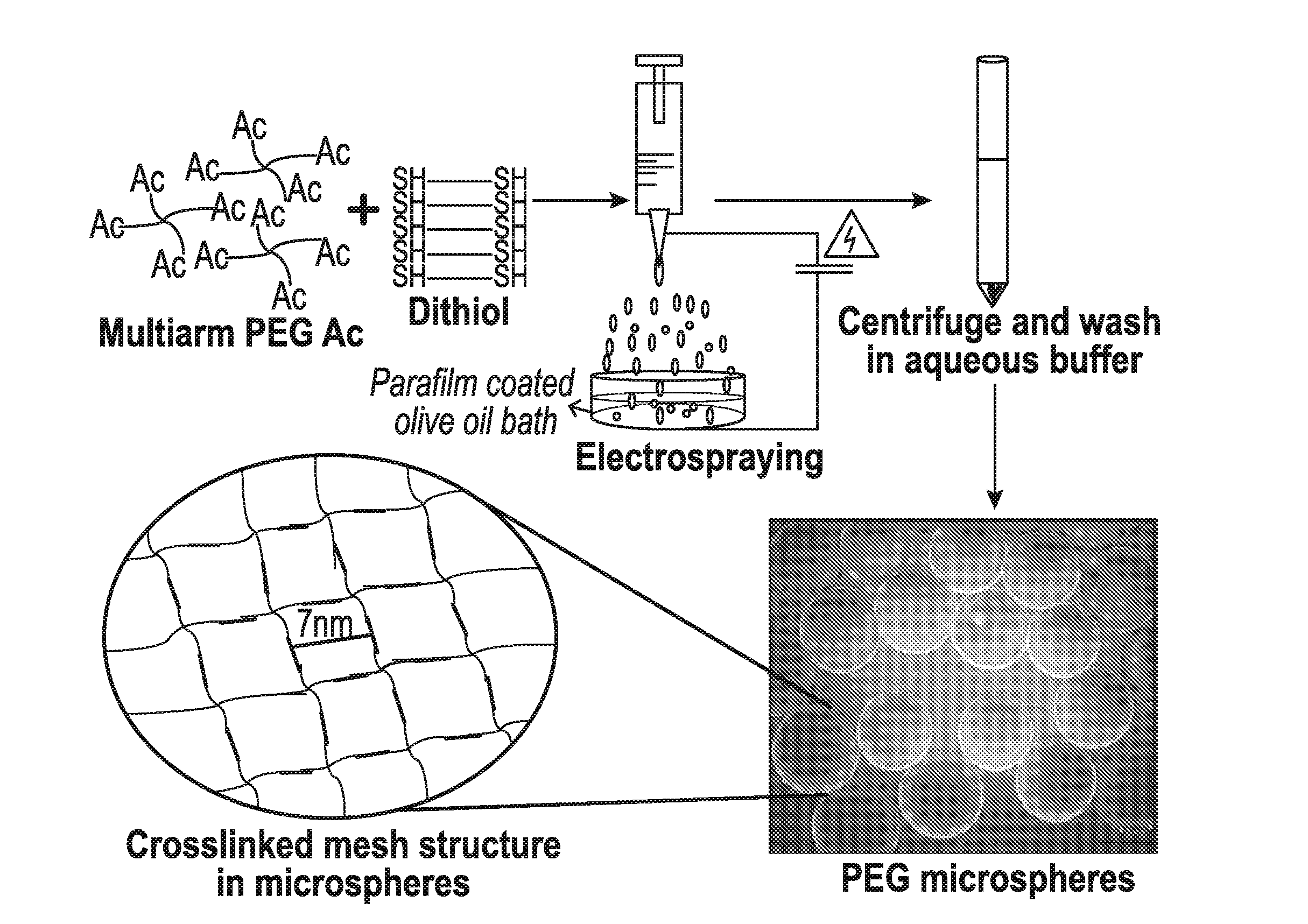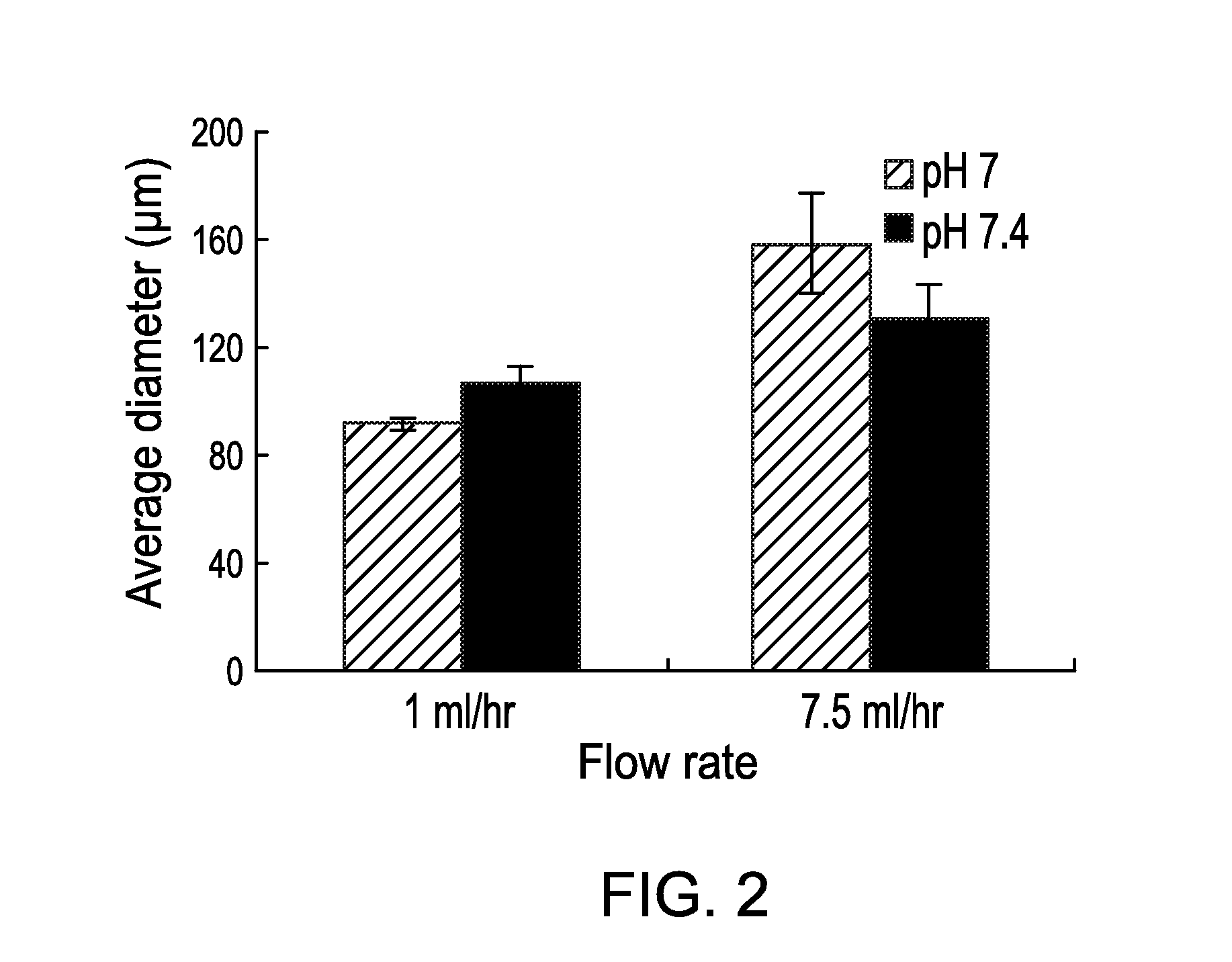Fabrication of hydrogel microsphere delivery vehicles through electrospraying and timed gelation
a technology of hydrogel microspheres and hydrogel particles, which is applied in the direction of peptidases, enzymology, peptide/protein ingredients, etc., can solve the problems of limiting the application of biological applications such as cell or protein encapsulation, limiting the range of applications, and affecting the biological effect of the application
- Summary
- Abstract
- Description
- Claims
- Application Information
AI Technical Summary
Benefits of technology
Problems solved by technology
Method used
Image
Examples
example 1
[0058]In this Example, electrospraying was used to prepare polyethyleneglycol hydrogel microspheres.
[0059]A 20% w / v stock solution of 4 arm PEG-Ac was made in 0.3 M triethanolamine (TEA) buffer (made in 1× PBS) of pH 7 and pH 7.4. A 5% stock was made for the thiol crosslinkers in 0.3 M TEA buffer of pH 8. To prepare a 10% gel precursor solution the PEG-Ac and thiol crosslinker were combined in 1:2 molar ratio in 0.3 M TEA buffer of either pH 7 or 7.4. Food dye (5% v / v) was also included in the preparation to aid in visualization of the particles. The precursor solution was mixed by gentle pipetting and transferred to a 1 ml syringe. For making the microspheres the syringe was mounted on syringe pump (Harvard Apparatus 22, Biosurplus) to dispense the solution at a desired rate. A high voltage generator (Spellman High Voltage Electronics Corporation) was then used to generate electric field between the nozzle and the collector. The solution was electrosprayed as fine droplets onto a c...
example 2
[0061]In this Example, gelation time of microspheres formed by electrospraying was investigated to determine the maximum time for electrospraying the particle before completion of gelation.
[0062]The hydrogel microspheres formed at three different pHs (7, 7.4 and 8.5) gelled in 23 minutes, 10 minutes, and 1 minute 30 seconds. Thus for the purpose of this study, pH 7 and 7.4 were used for making hydrogel microspheres to provide sufficient time to spray microspheres of the pre-polymer solution and then allow them to gel. Furthermore, the microspheres sprayed using precursor solution of pH 7 and 7.4 under identical processing conditions had similar size distribution (FIG. 2).
example 3
[0063]In this Example, collecting medium with different surface properties was investigated to determine adherence of the particles to the collecting medium upon electrospraying.
[0064]Collecting media including glass petri dishes, cell culture polystyrene dishes, glass dishes coated with RAIN-X® and PARAFILM M® covered glass base were tested to obtain a hydrophobic, dry and inert surface for collecting microsphere particles.
[0065]The PARAFILM M® covered base provided a smooth hydrophobic surface to which the particles being sprayed did not adhere or exhibited minimal adhesion. However, the sprayed particles, being hydrogel, dried up quickly due to water loss by evaporation on the PARAFILM M® covered base.
[0066]To prevent hydrogel microsphere drying and obtain well dispersed microsphere particles, the sprayed particles were collected in an oil bath. Three oils tested were olive oil, mineral oil and silicone oil in order of increasing density respectively.
[0067]In the case of both oli...
PUM
| Property | Measurement | Unit |
|---|---|---|
| Flow rate | aaaaa | aaaaa |
| Magnetic field | aaaaa | aaaaa |
| Magnetic field | aaaaa | aaaaa |
Abstract
Description
Claims
Application Information
 Login to View More
Login to View More - R&D
- Intellectual Property
- Life Sciences
- Materials
- Tech Scout
- Unparalleled Data Quality
- Higher Quality Content
- 60% Fewer Hallucinations
Browse by: Latest US Patents, China's latest patents, Technical Efficacy Thesaurus, Application Domain, Technology Topic, Popular Technical Reports.
© 2025 PatSnap. All rights reserved.Legal|Privacy policy|Modern Slavery Act Transparency Statement|Sitemap|About US| Contact US: help@patsnap.com



